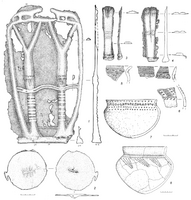Itkul culture
56°05′24″N 60°18′00″E / 56.090000°N 60.300000°E
Sarmatian culture |
The Itkul culture (Ru: Иткульская культура, 7th-5th century BCE) is one of these Early Saka culture, based in the eastern foothills of the Urals.[2] The Itkul culture was part of an East to West mouvement of Asiatic Saka tribes towards the Ural regions during the Iron Age (c.1000 BCE and later) period.[2] Other Saka groups, such as the Tasmola culture circa 600 BCE, were also involved in similar mouvements and settled in the southern Urals.[2]
The Itkul culture was a culture of metalworkers.[3] They played a key role in exploited the metallurgical ressources of the Urals, and established fortified settlements to protect them.[3] They were probably provided of metal weapons for other tribes of the steppes.[2]
The Itkul culture was eventually assimilited into the Early
-
Itkul culture artifacts: 1 to 4-Kuganak hoard 5 to 6-Akberdino 3 settlement 7-Elder Shipovo burial ground 8-Kasianov hillfort (1-4 bronze; 5-8 ceramics)
-
Itkul housing reconstruction
References
- ISBN 978-0-87099-959-8.
- ^ ISSN 0960-9822.
- ^ ISSN 2352-409X.


